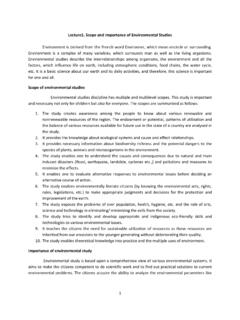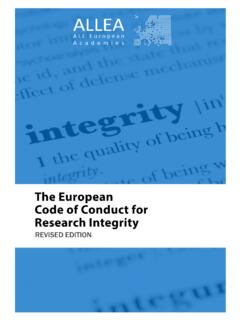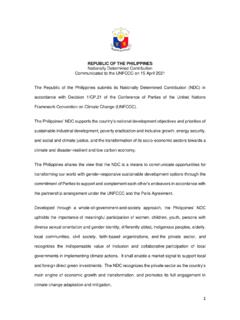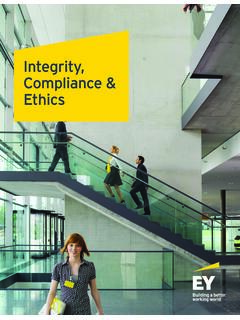Transcription of Office of Justice Programs National Institute of Justice
1 Department of JusticeOffice of Justice ProgramsNational Institute of JusticeR e s e a r c h i n B r i e fNational Institute of JusticeJulie E. Samuels, Acting Measurement of Police IntegrityBy Carl B. Klockars, Sanja Kutnjak Ivkovich, William E. Harver, and Maria R. HaberfeldMay 2000individual approach, sometimes calledthe bad apple theory of police corrup-tion, has been subject to severe criticismin recent Research in Brief summarizes astudy that measured police integrity in 30police agencies across the United study was based on an organiza-tional/occupational approach to policecorruption. Researchers asked officersfor their opinions about 11 hypotheticalcases of police misconduct and measuredhow seriously officers regarded policecorruption, how willing they were to sup-port its punishment, and how willing theywere to report it.
2 The survey found sub-stantial differences in the environmentsof integrity among the agencies more serious the officers considereda behavior to be, the more likely theywere to believe that more severe disci-pline was appropriate, and the more will-ing they were to report a colleague forengaging in that approachesto corruptionPioneered by Herman Goldstein,1 con-temporary theories of police corruptionare based on four organizational andoccupationaldimensions. Each isdescribed the history of virtually every policeagency attests, policing is an occupationthat is rife with opportunities for miscon-duct. Policing is a highly discretionary,coercive activity that routinely takesplace in private settings, out of the sightof supervisors, and in the presence of wit-nesses who are often regarded as unreli-able.
3 Corruption the abuse of policeauthority for gain is one type of mis-conduct that has been particularly prob-lematic. The difficulties of controllingcorruption can be traced to several fac-tors: the reluctance of police officers toreport corrupt activities by their fellowofficers (also known as The Code, TheCode of Silence, or The Blue Curtain ),the reluctance of police administrators toacknowledge the existence of corruptionin their agencies, the benefits of the typi-cal corrupt transaction to the parties in-volved, and the lack of immediate victimswilling to report recently, police administratorsviewed corruption primarily as a reflec-tion of the moral defects of individualpolice officers. They fought corruptionby carefully screening applicants for po-lice positions and aggressively pursuingmorally defective officers in an attemptto remove them from their positions be-fore their corrupt behavior had spreadthrough the agency.
4 This administrative/Issues and FindingsDiscussed in this Brief: Research ex-ploring police officers understanding ofagency rules concerning police miscon-duct and the extent of their support forthese rules. The survey also consideredofficers opinions about appropriatepunishment for misconduct, their famil-iarity with the expected disciplinarythreat, their perceptions of disciplinaryfairness, and their willingness to reportmisconduct. The results of this surveyhave important implications for re-searchers and policymakers, as well asfor police issues: Until recently, most stud-ies of police corruption were basedon a traditional administrative ap-proach one that views the problemof corruption primarily as a reflectionof the moral defects of individual po-lice officers. This research, however, isbased on the organizational theory ofpolice corruption, which emphasizesthe importance of organizational andoccupational asked officers in 30 agencies for their opinions aboutvarious hypothetical cases of police mis-conduct, thereby avoiding the resis-tance that direct inquiries about corruptbehavior would likely provoke.
5 The sur-vey measured how seriously officers re-garded police corruption, how willingthey were to report it, and how willingthey were to support punishment. Byanalyzing officers responses to the sur-vey questions, researchers were able torank the police agencies according totheir environments of integrity . The ca-pacity to measure integrity in this way isespecially significant for police adminis-trators, who, this research suggests,may be able to influence and cultivate2R e s e a r c h i n B r i e fonly among police agencies but alsowithin police agencies. Particularly inlarge police agencies, the occupationalculture of integrity may differ substan-tially among precincts, service areas,task forces, and work expectations. The fourth dimen-sion of police corruption that contemporarypolice theory emphasizes is the influenceof the social, economic , and political envi-ronments in which police institutions, sys-tems, and agencies operate.
6 For example,some jurisdictions in the United Stateshave long, virtually uninterrupted tradi-tions of police corruption. Other jurisdic-tions have equally long traditions ofminimal corruption, while still others haveexperienced repeated cycles of scandaland reform. Such histories indicate thatpublic expectations about police integrityexert vastly different pressures on policeagencies in different jurisdictions. Theseexperiences also suggest that public pres-sures to confront and combat corruptionmay be successfully challenges tothe study of police corruptionAlthough many theories can be applied tothe study of police corruption, the contem-porary organizational/occupational culturetheory has an important advantage over thetraditional administrative/individual bad-apple theory: The organizational/occupa-tional approach is much more amenableto systematic, quantitative is extremely difficult to studyin a direct, quantitative, and empiricalmanner.
7 Because most incidents of cor-ruption are never reported or recorded,official data on corruption are best re-garded as measures of a police agency santicorruption activity, not the actuallevel of corruption. Even with assurancesof confidentiality, police officers are un-Organizational rules. The first dimen-sion concerns how the organizationalrules that govern corruption are estab-lished, communicated, and understood. Inthe United States, where police agenciesare highly decentralized, police organiza-tions differ markedly in the types of ac-tivities they officially prohibit as corruptbehavior. This is particularly true of mar-ginally corrupt or mala prohibita behav-ior, such as off-duty employment andacceptance of favors, small gifts, freemeals, and discounts. Further complicat-ing the problem, the official policy ofmany agencies formally prohibits suchactivities while their unofficial policy,supported firmly but silently by supervi-sors and administrators, is to permit andignore such behavior so long as it is lim-ited in scope and conducted and control second dimension of corruption em-phasized in contemporary approaches isthe wide range of mechanisms that policeagencies employ to prevent and controlcorruption.
8 Examples include educationin ethics, proactive and reactive investi-gation of corruption, integrity testing, andcorruption deterrence through the disci-pline of offenders. The extent to whichagencies use such organizational anticor-ruption techniques varies Code. The third dimension of cor-ruption, inherent in the occupational cul-ture of policing, is The Code or The BlueCurtain that informally prohibits or dis-courages police officers from reporting themisconduct of their colleagues. The pa-rameters of The Code precisely what be-havior it covers and to whom its benefitsare extended vary among police agen-cies. For example, The Code may apply toonly low-level corruption in some agen-cies and to the most serious corruption inothers. Furthermore, whom and what TheCode covers can vary substantially notenvironments of integrity within findings: Based on officers responses to questions relating to 11hypothetical case scenarios involvingpolice officers engaged in a range ofcorrupt behavior, the following con-clusions emerged:lIn assessing the 11 cases of po-lice misconduct, officers consideredsome types to be significantly lessserious than more serious the officersperceived a behavior to be, themore likely they were to think thatmore severe discipline was appro-priate, and the more willing theywere to report a colleague whohad engaged in such officers evaluations of theappropriate and expected disciplinefor various types of misconduct werevery similar.
9 The majority of policeofficers regarded the expected disci-pline as majority of police officers saidthat they would not report a fellowofficer who had engaged in whatthey regarded as less serious mis-conduct (for example, operating anoff-duty security business; acceptingfree gifts, meals, and discounts; orhaving a minor accident while driv-ing under the influence of the same time, most policeofficers indicated that they wouldreport a colleague who stole froma found wallet or a burglary scene,accepted a bribe or kickback, orused excessive force on a car thiefafter a foot survey found substantial differ-ences in the environment of integrityamong the 30 agencies in the audience: Criminal justiceresearchers and policymakers, legis-lators, police administrators, policeofficers, and and e s e a r c h i n B r i e fresponses to the survey questionssuggests that all six integrity -relatedquestions measured the same phe-nomenon the degree of police intol-erance for corrupt seriousness.)
10 The 11 casescenarios fall into 3 categories of per-ceived seriousness. Four cases werenot considered very serious by policerespondents: Case 1, off-duty opera-tion of a security system business;Case 2, receipt of free meals; Case 4,receipt of holiday gifts; and Case 8,coverup of a police accident that in-volved driving under the influence ofalcohol (DUI). The majority of policerespondents, in fact, reported that theoperation of an off-duty security sys-tem business (Case 1) was not a viola-tion of agency policy. Respondentsconsidered four other cases of miscon-duct to be at an intermediate level ofseriousness: Case 10, the use of exces-sive force on a car thief following afoot pursuit; Case 7, a supervisor whooffers a subordinate time off duringholidays in exchange for tuning up hispersonal car; Case 9, acceptance offree drinks in exchange for ignoringa late bar closing; and Case 6, receiptof a kickback.
















